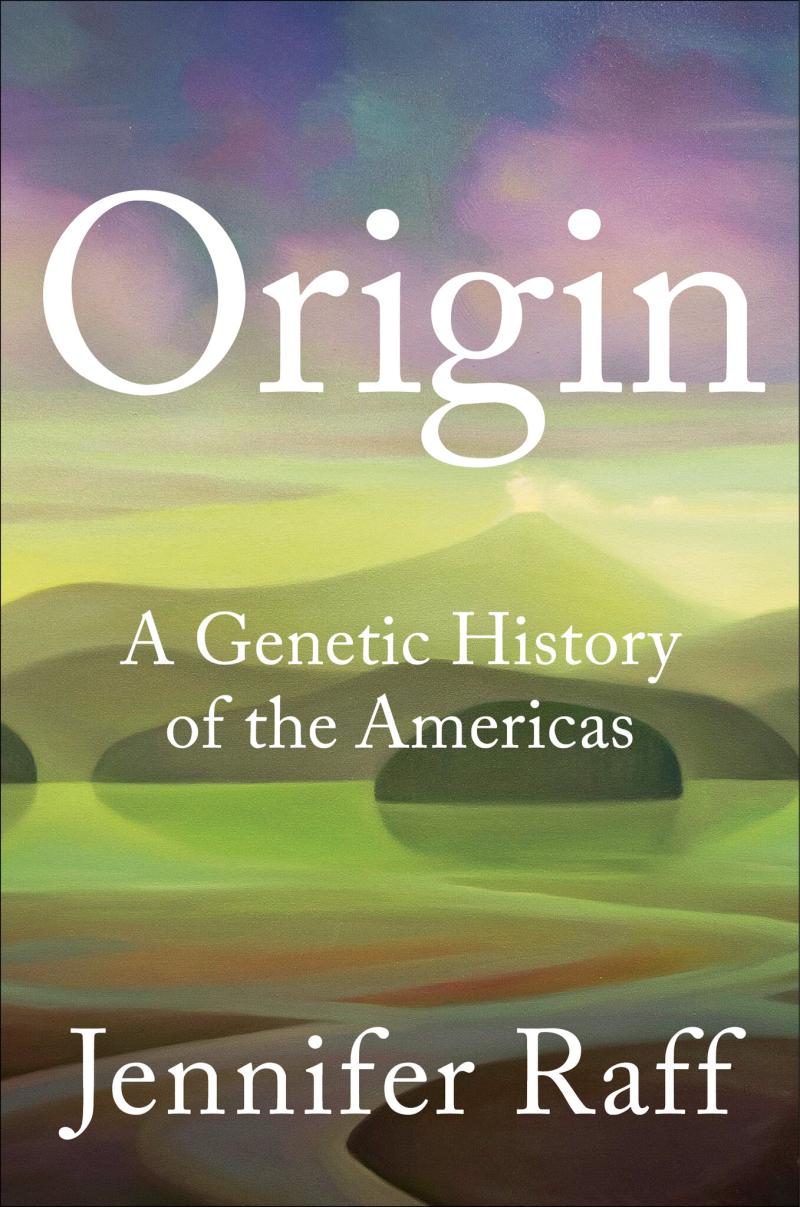Did the First Americans Arrive via Land Bridge? This Geneticist Says No.


On my list to read.....

ORIGIN
A Genetic History of the Americas
By Jennifer Raff
It’s Anthropology 101. At the end of the last ice age, around 13,000 years ago, retreating glaciers created an inland corridor connecting Siberia to the Americas. People from northeast Asia crossed the Bering Strait land bridge and entered a new world. From there, these people — often given the name Clovis, after a New Mexico site that was rich with the distinctive stone tools they made — rapidly spread and successfully adapted to the various ecologies they encountered. All Native Americans can trace their ancestry back to these First Peoples.
But, according to the University of Kansas anthropological geneticist Jennifer Raff, that’s not quite how it happened.
In her new book, “Origin: A Genetic History of the Americas,” Raff beautifully integrates new data from different sciences (archaeology, genetics, linguistics) and different ways of knowing, including Indigenous oral traditions, in a masterly retelling of the story of how, and when, people reached the Americas. While admittedly not an archaeologist herself, Raff skillfully reveals how well-dated archaeological sites, including recently announced 22,000-year-old human footprints from White Sands, N.M., are at odds with the Clovis first hypothesis. She builds a persuasive case with both archaeological and genetic evidence that the path to the Americas was coastal (the Kelp Highway hypothesis) rather than inland, and that Beringia was not a bridge but a homeland — twice the size of Texas — inhabited for millenniums by the ancestors of the First Peoples of the Americas.
Throughout, Raff effectively models how science is done, how hypotheses are tested, and how new data are used to refute old ideas and generate new ones.
As a paleoanthropologist who works on fossils of ancient human ancestors living millions of years ago, I’ve never fully grasped why my colleagues who study the peopling of the Americas so fervently argue over a few thousand years. But Raff helps the reader understand why those several thousand years matter in terms of identifying source populations for the First Peoples of the Americas, the route they took (coastal versus inland) and the ecological challenges they faced. An informed and enthusiastic guide throughout, Raff takes the reader from underground caverns in Belize to a clean lab at the University of Kansas where ancient DNA is tediously teased from old bones. She explains difficult to understand concepts — geoarchaeology, coalescence times, biodistance — with well-placed sidebars. The book is richly referenced, and informative footnotes and endnotes give readers an opportunity to take a deeper dive if they wish.
As Raff explains, “We have promised to treat the small scraps of bone and teeth with respect and mindfulness that they are cherished ancestors, not ‘specimens.’” Sprinkled through “Origin” are lovely vignettes of life thousands of years ago. Raff playfully imagines how the Yana River boys lost their deciduous teeth in a Siberian river 31,000 years ago. She poignantly fills a page with the sorrow a family must have felt as they placed the limp body of their 2-year-old boy into the earth in south-central Nevada 12,600 years ago. Through a combination of rigorous science and a universal humanity, Raff gives ancient people a voice.
The first few chapters of “Origin” detail the long history of archaeology in the Americas. Here, we meet the usual characters — Thomas Jefferson, Ales Hrdlicka, Franz Boas — but also folks who were new to me. People like José de Acosta, a Jesuit priest who long ago predicted that the Indigenous peoples of the Americas were related to northeast Asian populations. And George McJunkin, a formerly enslaved man who made one of the most important archaeological discoveries of the 20th century at Folsom, N.M.
Given the fast and furious pace of discovery in this field, Raff is clear that not everyone will agree with her interpretations of the data. “All scientists must hold themselves open to the possibility that we could be wrong, and it may very well be that in five, 10 or 20 years, this book will be as out of date as any other,” she writes. “That possibility is what makes working in this field so rewarding.” That, she explains, is how science is done.
While science is the most objective way of understanding the natural world that humans have ever devised, it is still done by an emotional, subjective primate — us. Raff celebrates science, but also calls attention to the many ways science has harmed Indigenous communities. “Origin” details mistrust between some Native communities and helicopter scientists who have swooped into their lands and exploited them for their DNA without inviting input and participation from all stakeholders. The hashtag #decolonizescience looks good on Twitter and the concept sounds good in grants, but it rings hollow unless it is put into practice. Raff provides a road map for how to do this and convincingly argues why this must be the future of our science. In fact, “Origin” opens with the discovery of 10,000-year-old human bones from Shuká Káa Cave, Alaska, and details the constructive partnerships, built on transparency and trust, that emerged between scientists, Indigenous communities and federal agencies.
My only quibble with this outstanding book is that we don’t learn who Raff herself is and how she personally has contributed to this work through her scholarship until halfway through “Origin.” At the end of the book, she describes herself as “one obscure researcher from a small lab.” To be sure, there are much bigger labs than hers, but I think she’s being too modest. Jennifer Raff is a well-published scholar and accomplished scientific communicator who has contributed important insights into the genetic history and movement patterns of Indigenous Americans. She is at the forefront of a culture change in our science. And now she has written the book anyone interested in the peopling of the Americas must read.
ORIGIN
A Genetic History of the Americas
By Jennifer Raff
Illustrated. 328 pp. Twelve. $30.

Tags
Who is online
445 visitors

As I stated above, this is on my reading list.
Thanks Thomas - went to Amazon, found the Kindle and that this book only hit the market on 2/8/22 - damn new, ya know?
Kindle has it for $14.99.
What I will be looking for is to see if she has any references to Mann's "1492", specifically to the cave in Brazil (?) with 12 mummies supposedly 40K years old. Also am gonna hafta reread Mann's book and see what else I'm missing.
Luv this stuff.
My pleasure, 1st.
I know that some were discovered in Chile and they were dated to BCE 5050. Two thousands years older than the oldest Egyptian mummies.
It is on mine as well, Thomas. This is definitely on my must-read list.
She presents fascinating alternatives that can be very accurate. On a side note, most linguists believe that NA's came to the US 50,000 years ago. Which is a very different timeline that most current ''experts'' say.
I believe that this is inaccurate.
I believe he is talking about Anzick Boy AKA Montana Boy whose remains were found in Wilsall MT. not NV. It also made the connection (proof) that modern-day NA are descendants of the Clovis people.
Thank you for dropping by and commenting.
I think her statement that I quoted above is one that should be kept in mind, especially the attitude that such a statement comes from...
Agree.
Morning..our Kooris have been here for 50,000 years...
You mob might be related to us..
Umm second thoughts..just as well there is an ocean between us... don't want unexpected rellies (relatives) rolling up..
I resent being called a mob, a gang or a gaggle might do though or even a tribe.
Anyhow the supercontinent of Gondwana actually connected South America with Australia, so if I were you I'd put another shrimp on the barbie, the mob is headed at ya.
That makes a lot of sense in my head.
And you all would be more than welcome...
The snappies love fresh tourists...🦈🐊
Interesting but many millions of years ago. Do you think humans were evolving at that time? I think it's possible.
Do they like lemon, butter, garlic and rosemary? I'll be sure to marinate myself before I visit
I wouldn't be a tourist and besides, I'd be bringing Grizz with me. He's over 7th feet tall and weighs around 1500 lbs. Or I could talk to my rellies further north and bring Polar with me.
This is Grizz.
This is Polar.
Sorry, Thomas, I'm getting a bit off-topic.
Anything is possible, Trout.
Tricky question as our ancesters 180 million years ago could not be called human (maybe small rodents would be accurate) we were still evolving to become us
It is a tricky question, perhaps at that time in the history of the earth we were small rodents and the process of becoming human was in process. Since much of what we believe is a theory, it can be disproven with the next discovery. In the last 20 years, the advances/changes in what we thought was correct or fact has changed dramaticly.
Everybody likes bears
That is alright.
Only if I'm carrying a big damn gun to even the odds!
When hiking/camping in bear country I always carry a .44 magnum.
WTF, you're upsetting Yogi Bear.
Poor Yogi. All he wants is a pik-a-nick basket and cuddles with Boo-Boo
Lol one of my favourite sayings is "The only constant in life is change"
I am pretty sure the Zuni words for water, life, and sea turtle are the same in Japanese,
at least according to the NA Artist who made some of our stained glass sea turtles.
There was also something mentioned in Windtalkers?
Zuni ancient native americans in New Mexico speak Japanese - Strange Sounds
Interesting article, Thomas.
I spent a lot of time with the indigenous people of Thailand, the Ahka and the Karen. There were some very strong similarities in some of their words and Anishinaabe (Ojibwe) words and some of the dress worn by women there.
I think that you'll find this articles interesting since it's from our (NA) perspective and really supports what Raff is doing.
Very interesting. I would like to read her book.
We know that the Polynesians, thought to have originated from Southeast Asia, sailed across the Pacific Ocean using their knowledge of the stars, winds, tides and other natural elements. It is certainly possible that the earliest inhabitants of the Americas, probably originating from the same general location (Asia), did something similar even earlier than the Polynesians.
I've seen this study in various forms, it is difficult to argue with DNA.
It's quite possible that South Americans ventured west to Rapa Nui. Thor Heyerdahl and Kon-Tiki proved that.
Additionally this comment, '' This is because the Polynesians had far more advanced maritime technology,''
A study of South American and Carbi Indians showed that they traveled great distances over the ocean as did the natives of Alaska and PNW (help highway)
Anyhow it presents yet another theory in the settling of the Americas.
This is an interesting article on the differences between the peopling of north, central and south America.
As a side note, every year in Hawaii on the Big Island there is a NA Pow Wow and it is attended by many Polynesian people, Hawaiian, Samoan, Tonga, etc. It's quite enjoyable to mix with the Polynesian people mixing the cultures of north Americans and Polynesians.
The "kumara"/"kumala" link has long been considered significant by anthropologists, historians and linguists.
There is no way that it can be a mere coincidence.
The article you cited refers to "Hawaiki" (sometimes stated as "Havaiki") as the ancestral homeland of the Polynesians, and it makes reference to Taiwan. I have also read in the past that Java may be "Hawaiki", as the names "Hawaii", "Tahiti" and "Savai'i", a major island in Samoa, are all cognates and may derive from "Java". The Hawaiians knew Tahiti as "Kahiki".
To add to our research, here is a 2020 article from the Smithsonian Magazine:
While I absolutely agree that there was a human migration (maybe multiple) using the land bridge, I have always had a problem believing it was the only or earliest migration
I agree with you Freefaller as do many NA's.
I would recommend that you read, ''Red Earth, White Lies'' by Vine Deloria Jr. He digs into the ''land bridge theory'' and is a really interesting read.
I'll put it on the list but I'm waiting for this one to arrive and read first
Origins and Red Earth, White Lies will make a great back to back combo. In his book, Deloria takes on more than the Landbridge theory and it all works together to a larger theme.
I think
the assumptionthat any one route cannot be "the way" that humans came to populate the Americas. People seem to like moving around, and from what the DNA evidence is telling us, apparently they have for some time.(Is the urge to escape your relatives that engrained in people?)
Agreed
You don't know my relatives.
Escaping them is a fulltime job.
Let's throw more mystery into the Polynesian/Indian connection. My people, the Ojibwe have a sacred shell called the Cowrie or Miigis shell. Remember we are mostly concentrated in the upper Midwest of the US and central Canada. Thousands of miles from any ocean, yet here we are with the Miigis shell that are found in the So. Pacific, the Indian Ocean, and the Southern Atlantic.
Yet here we are in the middle of North American with these shells.
No one seems to have an answer except the people that scientists should ask, the Ojibwe. Did we travel far and wide across the world collecting these shells did we trade with Carbi Indians or Polynesian people for them?
Cowrie shells were significant in African and Brazilian cultures as well.
If the Ojibwe people did not live near the coast, it would seem most logical that the shell was acquired through trading networks.
It's not clear to me from your comment if there is just one sacred shell, or more than one, and they are all considered sacred.
The white miigis shell, G.
Understood. It is not just one single sacred shell, but rather, the type of shell of which the Ojibwe have many.
Correct.
Cowrie shells are my favourite shell of all...I have collected hundreds over the years from many places..
Little did I realise I could find them in my own backyard...one of my favourite hobbies was collecting them but can no longer do it. To long a walk and to hard to climb up and down cliffs..
The Kooris in my area had no interest in shells as trade, was more kangaroo, koala and possum furs...they had little interaction with neighbouring mobs.
The answer to that question lies in the the Seven Fires Prophecy of the Ojibwe.
I think that we owe Thomas, who seeded this article a round of applause for seeding an interesting subject that is developing as we speak and it's not political or religious.
Thank you all very much also. Everybodies contributions have been great!
Kind of a semi-directed exploration.
Well, this book is going to be a must for me. She is confirming a lot of what a lot of the new data had suggested. You got to love DNA. It has been such a game-changer.
Thanks for posting this Tom!
I've always thought that the coastal route made more sense. It certainly makes it easier to reconcile the rise of different areas at the same time.
Well now I have yet another book enqueued on my Kindle. Need to decide if I read Origin before Kavika's suggestion of "God is Red".
Okay, decided. Will read the history of homo sapiens who first occupied this land before reading about the religions that evolved from them.
I'm looking forward to getting Origins. I ordered it from Amazon today.
I did also!
I've been under the impression that there were many routes to the Americas via land and sea by it's earliest settlers. I think we'll know soon enough which groups immigrated from where.
You'll find this link very interesting. NA and unknown people of Siberia share much the same DNA.
This is a good article:
Excellent article, EG.
Actually, all NA's know where we came from, it's no secret among us. We don't let anyone else know so to have that mysterious aura about us.
An interesting and true story of an anthropologist that tried to discover where the Hokum people of the SW disappeared to, they simply vanished. After years of study, research digs etc she finally figured out that the Hokum people are today Tohono O'odham people. She had a meeting with the Tohono people and told them of her work/research that lead her to this finding. They looked at her and said, ''we know that'''' you could have saved yourself a lot of work by simply asking us.
Moral of the story is that native people have a far better understanding of ourselves and our history than anyone else. Our oral history has been proved to be correct time and again.
One would think starting with the oral histories would be the place to start not finish.
Yes, it would be the obvious way but unfortunately, that isn't what is done in the majority of cases EG.
I am going to order it today. This stuff fascinates me.
I finished Origin. Anyone else?